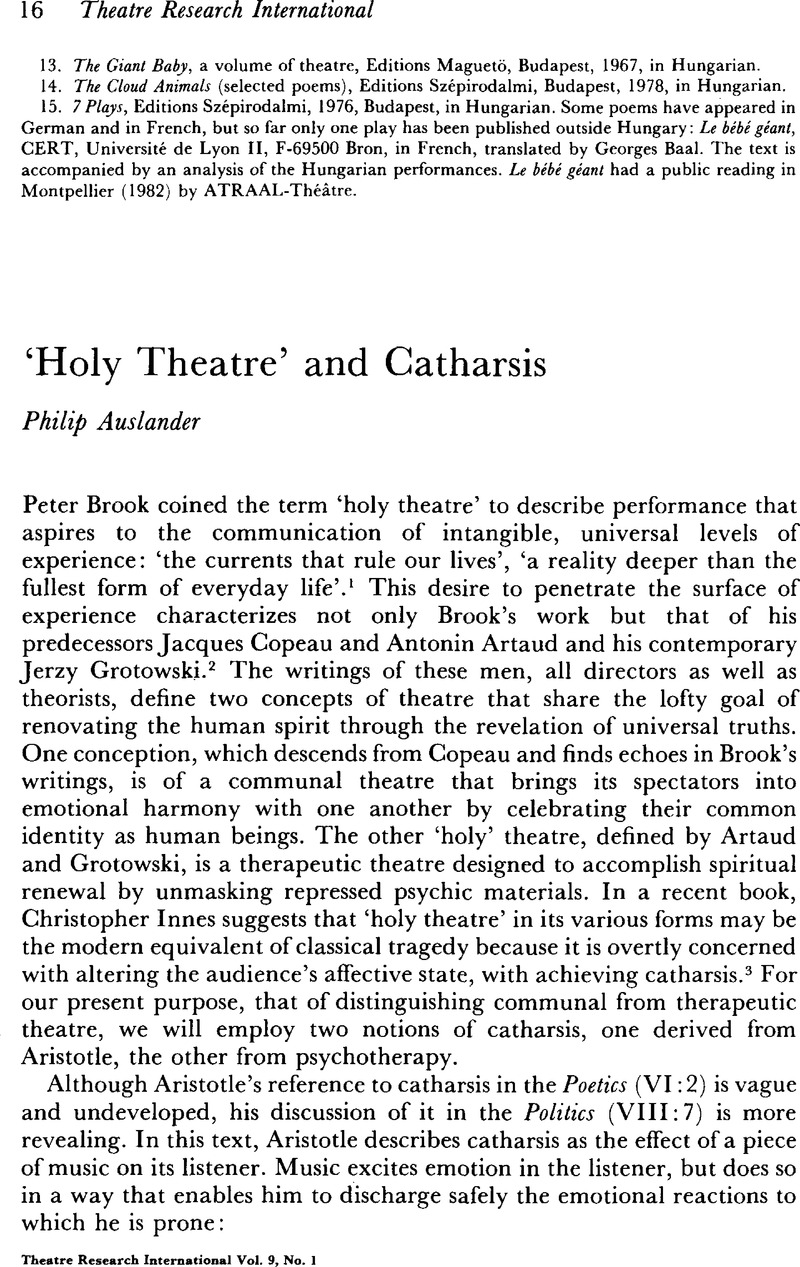Published online by Cambridge University Press: 23 January 2009

1. Brook, Peter, The Empty Space (New York: Avon, 1969), p. 40.Google Scholar Subsequent references to all sources quoted more than once will be cited in the text.
2. The examples of ‘holy theatre’ mentioned by Brook are the work of Artaud, Grotowski, the Living Theatre, Samuel Beckett, and Merce Cunningham.
3. Innes, Christopher, Holy Theatre: Ritual and the Avant Garde (New York: Cambridge Univ. Press, 1981), pp. 253–4.Google Scholar
4. My discussion of Aristotle follows Humphry House, Aristotle's Poetics (London: Rupert Hart-Davis, 1958), pp. 100–11Google Scholar and Brunius, Teddy, Inspiration and Katharsis, Swedish Studies in Aesthetics, No. 3 (Uppsala: Uppsala Univ., 1966), pp. 55–9.Google Scholar Both use J. Burnet's translation of Aristotle.
5. Scheff, T. J., Catharsis in Healing, Ritual, and Drama (Berkeley: Univ. of California Press 1979) p. 13.Google Scholar
6. See Osborne, Harold, Aesthetics and Criticism (Westport: Greenwood Press, 1973), p. 108.Google Scholar
7. Jacobi, Jolande, The Psychology of C. G. Jung, 1973 ed. (New Haven: Yale Univ. Press), p. 10.Google Scholar
8. Copeau, Jacques, Notes sur le métier de comédien (Paris: Michel Brient, 1955), pp. 38–9.Google Scholar
9. Copeau, , ‘Une Renaissance dramatique est-elle possible?’ Revue Générate (Brussels), 15 04 1926, p. 415Google Scholar as quoted in Anders, France, Jacques Copeau et le Cartel des Quatre (Paris: Nizet, 1959), p. 68.Google Scholar
10. Leigh, Barbara Kusler, ‘Jacques Copeau's School for Actors’, Mime Journal, No. 9/10 (1979), p. 13.Google Scholar
11. See Eldredge, Sears A., ‘Actor Training in the Neutral Mask’, TDR, 22, No. 4 (1979), p. 20.Google Scholar
12. Eldredge, , ‘Jacques Copeau and the Mask Actor Training’, Mime, Mask and Marionette, 2, No. 3/4 (1979–1980), p. 220.Google Scholar
13. Frank, Waldo, ‘Copeau Begins Again’, Theatre Arts Magazine, 9 (1925), 589.Google Scholar
14. Brook states: ‘We used Artaud's striking title to cover our own experiments…although many exercises were very far from what he had proposed’. (45) Much of the work done by Brook under the Theatre of Cruelty rubric was dedicated to determining the minimum requirements for theatre, an issue of greater interest to Copeau and Grotowski than to Artaud.
15. Smith, A. C. H., Orghast at Persepolis (New York: Viking, 1972), pp. 43–4.Google Scholar
16. Artaud, Antonin, ‘Le Théâtre et son double’, in Oeuvres Complètes IV (Paris: Gallimard, 1964), p. 109.Google Scholar
17. This list is in thejean Dasté collection of the Bibliothèque de l'Arsenal, as quoted in Eldredge, , ‘Jacques Copeau and the Mask’, p. 210.Google Scholar
18. Wiles, Timothy J., The Theater Event: Modern Theories of Performance (Chicago: Univ. of Chicago Press, 1980), p. 127.Google Scholar
19. Grotowski, Jerzy, Towards a Poor Theater (New York: Simon and Schuster, 1968), p. 118.Google Scholar
20. Cf. Copeau: ‘Le tout du Comédien, c'est de se donner’ (Notes, p. 31).
21. Grotowski, quoted by Mennen, Richard, ‘Jerzy Grotowski's Paratheatrical Projects’, TDR, 19, No. 4 (1975), p. 58.Google Scholar See also: Kumiega, Jennifer, ‘Laboratory Theatre/Grotowski/The Mountain Project’, Theatre Papers, 2, No. 9, pp. 1–23Google Scholar; Cashman, Daniel E., ‘Grotowski: His Twentieth Anniversary’, TJ, 31, No. 4 (1979), 460–6Google Scholar; and Findlay, Robert, ‘Grotowski's “Cultural Explorations Bordering on Art, Especially Theatre”’, TJ, 32, No. 3 (1980), 349–56.Google Scholar
22. Grotowski, , ‘Holiday: The Day that is Holy’, tr. Taborski, Boleslaw, TDR 17, No. 2 (1973), pp. 133–4.Google Scholar